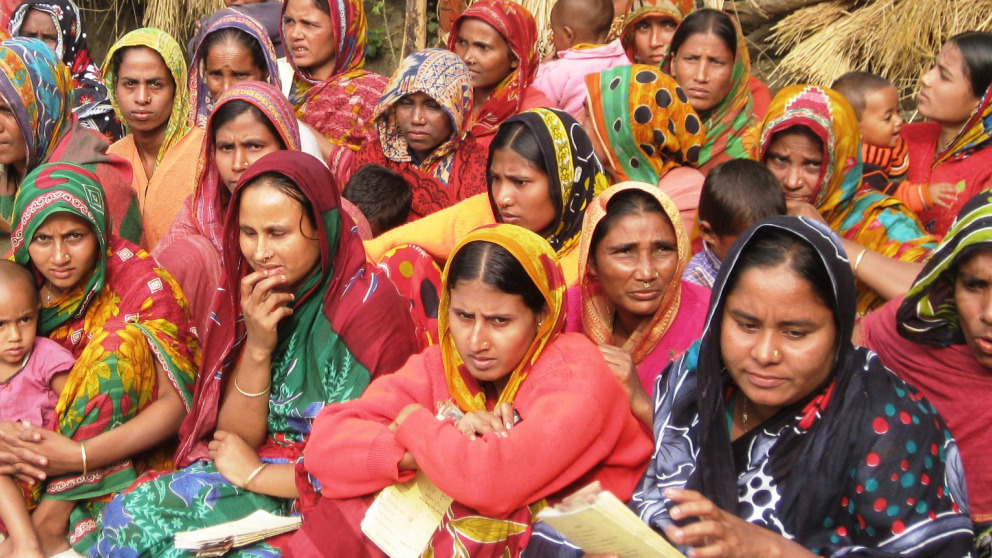Headline:
Pro-poor Adaptation in Practice

In the past few years, there has been a growing consensus that climate change adaptation is a multi-faceted challenge; it cannot be addressed by simple solutions. The terms ‘integrated’, ‘multi-scalar’ and ‘comprehensive’ have all been used to describe the kind of measures required, with the underlying message to keep it complex!
All right, we got the message, but the question remains: how should adaptation work in practice? Can we – the ‘climate people’ – really conceive adaptation measures without going into the field and engaging directly with those at the forefront of the climate battle? Without a face-to-face dialogue with the rural poor? Certainly not. But at the same time, we have to abstract to a certain degree from specific contexts. We cannot remain at the level of individual case studies and measures; common lessons can and should be derived.
Aiming for this balance between specificity and generalisation, the IASS and the International Fund for Agricultural Development (IFAD) joined forces with seven civil society organisations from six countries around the world to distil general lessons on pro-poor adaptation, focusing on resource governance. The study Pro-Poor Resource Governance under Changing Climates builds on seven case studies that were designed and carried out together with the following civil society organisations:
| Country | Organisation |
| Bangladesh | BRAC |
| Bolivia 1 | Fundación Tierra |
| Bolivia 2 | University of Bern, UMSA/Faculty of Agronomy and Fundación PIAF-El Ceibo |
| Brazil | PATAC |
| Burkina Faso | GRAF |
| Ecuador | SIPAE |
| India | Seva Mandir |
The study – which is also available in Spanish and French – documents, analyses and communicates cases of pro-poor resource governance. It asks how resource governance determines some of the factors that engender livelihood vulnerability and shows to what extent changed institutions affect livelihoods, making them vulnerable to external changes that originate in climatic and non-climatic processes.
So what did we find out? Every case study provided its own insights and results. However, in our attempt to identify common threads and lessons, we reached some general core conclusions:
Putting technologies in context
When adapted to the needs of smallholder farmers, technological solutions can improve the livelihoods of poor rural people, but as they are deeply embedded in history and politics, they face significant barriers to scaling up at the local governance level.
In Brazil, for example, such solutions were very well received and their adoption has been sustained after they were put to the test by local farmers and strongly embedded in their social context. The main barriers were found in local governance structures, where the political and economic interests of traditional elites tend to prevail.
Community rights are not enough
Recognition of community rights, including common property institutions, is one avenue for reducing the vulnerability of poor rural populations. However, this needs to be accompanied by other supporting measures such as the facilitation of community negotiations on benefit sharing or the implementation of soil and water conservation measures. Otherwise, community rights may not suffice to initiate a comprehensive development process that ends poverty.
This can be seen in India, where often marginalised tribal communities are extremely dependent on natural resources for their livelihoods and lack alternatives. Even where community rights were secured and supporting measures put in place, the benefits were usually not enough to lift communities out of chronic poverty.
Pro-poor adaptation is politics
Pro-poor adaptation can imply the redefinition of rights to resources and these processes are manifestly political. In order to reduce vulnerability, resource governance reforms have to consider how poor rural groups interact with those political processes, i.e. to what extent they are represented in and incorporated into decision-making.
Ecuador is a good example of how political action managed to end the structural marginalisation of indigenous communities in the face of rising pressure on natural resources. This case shows how some communities have managed to organise themselves and thus influence local political processes. In those cases, they were found to be in much more favourable positions in water disputes, as well as coping with a surge in land acquisition by foreigners.
Conclusion:
This endeavour has demonstrated that research collaboration with civil society organisations, a type of transdisciplinary research, can be very fruitful. It results in meaningful insights into the local level that are also relevant for higher levels, in both research and policy.
Overall, the study shows that changes in climate patterns interact with a pre-existing socio-environmental setting. In some cases, new sources of vulnerability can be attributed to recent changes in climate patterns and not only to climate variability. In others, however, climate change is expected to pose additional threats in the future, but for the moment they play a minor role in defining the vulnerability of poor rural groups
Feel free to download the different versions of this study:
 |
 |
||
| A SUMMARY REPORT of the book aimed at policymakers and practitioners | The FULL STUDY with the seven case studies in English |
 |
 |
||
| The full study in SPANISH | The full study in FRENCH |
This blog post was first published on the Climate & Development Knowledge Network blog.
Header photo: Judith Rosendahl

Add new comment